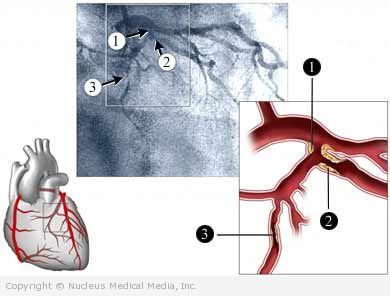Angiography
(Catheter Angiography; Arteriography; Angiogram)
Angiography – Definition
An angiography is an x-ray exam of the blood vessels. The exam uses a chemical that is injected into your blood vessels to make them more visible on the x-ray.
Angiography – Reasons for Procedure
This procedure may be done to:
- Help doctors identify narrowed, enlarged, and blocked blood vessels
- Determine if there is blood leaking out of the vessels and into other parts of your body
In some cases, the doctor can treat a blocked blood vessel during the procedure. This would prevent the need for another procedure.
Angiography – Possible Complications
Complications are rare, but no procedure is completely free of risk. If you are planning to have an angiography, your doctor will review a list of possible complications, which may include:
- Allergic reaction to chemical used
- Abnormal heart beats ( arrhythmias)
- Bleeding at point of catheter insertion
- Damage to blood vessels, which can cause damage to organs and tissue
- Kidney damage from contrast material
- Infection
- Stroke
Factors that may increase the risk of complications include:
- Allergies, especially to x-ray dye, iodine, medicines, or certain foods including shellfish
- Kidney problems
- Diabetes
- Bleeding disorder
Angiography – What to Expect
Prior to Procedure
Before the test, your doctor will likely:
- Do blood tests
- Ask about:
- Your medical history
- Medicines you take
- Allergies
- Whether you are pregnant or trying to get pregnant
- Perform a physical exam
In the days before your procedure, you will need to:
- Arrange for a ride to and from the procedure.
- Follow your doctor’s instructions. You may need to make changes in your medicines or your eating and drinking habits.
Angiography – Anesthesia
A local anesthesia will be injected into your arm or groin. Your catheter will be inserted there. A small dose of sedative may also be given by IV.
Angiography – Description of the Procedure
The area of the groin or arm where the catheter will be inserted is shaved and cleaned. The area will be numbed with the anesthetic. A small incision will be made into your skin. A catheter (small tube) will be placed through the incision into an artery. The doctor will guide the catheter through the arteries to the area to be examined. The contrast material is injected through the catheter. The doctor watches the procedure on a nearby monitor. Several sets of x-rays are taken. The catheter is then removed. Pressure will be applied to the area for about 10 minutes.
Angiography – How Long Will It Take?
Less than an hour to several hours if the doctor decides to fix any problems at the same time
Angiography – How Much Will It Hurt?
Although the procedure is not painful, you may feel the following discomfort:
- Brief sting when local anesthesia is injected
- Pressure when catheter is inserted
- Hot and flushed sensation when contrast material is injected
Angiography – Post-procedure Care
At the Care Center
Immediately following the procedure:
- You will need to lie flat for a period of time. The length of time will depend on your overall health and the reason for the exam.
- You may need to have pressure applied to the entry site to control bleeding.
- Tell the nurse if you notice any swelling, bleeding, black and blue marks, or pain where the catheter was inserted.
- You will be encouraged to drink a lot of fluids to flush the contrast material from your system.
- You may be allowed to leave the hospital after this recovery period. The length of your stay will depend on your other medical problems.
At Home
After your procedure, be sure to follow your doctor’s instructions.
When you return home after the procedure, do the following to help ensure a smooth recovery:
- Drink extra fluids, as instructed by your doctor. This will help flush the contrast material from your system.
- Do not lift heavy objects or do any strenuous exercise or sexual activity for at least 24 hours or longer as directed by your doctor.
- Change the dressing around the incision area as instructed.
- Take medicines as instructed.
- Ask your doctor when it is safe to shower, bathe, or soak in water.
Angiography – Results
The radiologist will examine the x-rays and report the findings to your doctor. Your doctor will discuss the findings and any treatment options needed with you.
Angiography – Call Your Doctor
After arriving home, contact your doctor if any of the following occurs:
- Signs of infection, including fever and chills
- Redness, swelling, increasing pain, excessive bleeding, or any discharge from the injection site
- Extreme sweating, nausea, or vomiting
- Extreme pain, including chest pain
- Leg or arm feels cold, turns white or blue, or becomes numb or tingly
- Difficulty breathing
- Any problems with your speech or vision
- Facial weakness
In case of emergency, get medical care right away .

